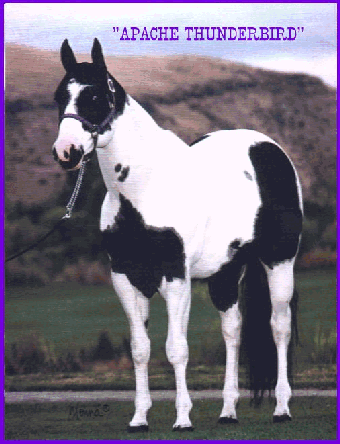

The Pinto descends from the Spanish Horses exported to America in the sixteenth century. The Pinto, called a Paint Horse if it is a purebred Quarter Horse or Thoroughbred, is a type of horse distinguished by its coloration and is found all over the world. It only has breed status in America.
The Pinto Horse Association of America was established in Ellington, Connecticut, in 1956 and recognized the Pinto as a breed in 1963. There is also the American Paint Horse Association in Forth Worth, Texas.
The Pinto Association recognized four types of colored horses: 1. Stock type; 2. Hunters, predomionantly Thoroughbred; 3. Pleasure type; and 4. Saddle type. It also has a similar classification for colored ponies.
The American Indian favored the Pinto for its unusual coloring and also because the blotched coat was a natural camouflage. The Pinto was also popular with the western cowboys. The Pinto has two types of coloring: Overo and Tobiano. The first is a recessive gene, predominant in South America, and the second a dominant one, more pronounced in North America. The Overo has a basic solid coat with large, irregular splashes of white over it. The Tobiano has a white base coat with large irregular patches of a solid color.
A good, sensible head can be found frequently among the very best Indian ponies. While there are some Thoroughbred-type Pintos, most are all-around animals that are not unlike those agile specimens so beloved by the American Indian. A particularly pleasing topline, both graceful and symmetrical, is an attractive feature of the Pinto. Most Pintos incline toward the stock horse type and has the associated conformation. A good example of that sort of animal is a powerful horse, very strong in the quarters and well proportioned. Modern Pintos have good limbs. They are bred carefully, particular attention being paid to the correctness of the lower limbs and hooves. The majority of Pintos are noted for their easy, comfortable paces that can be maintained over long distances, an important requirement in days gone by. The sparse tail of the Pinto is also a characteristic of the Appaloosa. Tails like this were encouraged by selective breeding because they did not get entangled with undergrowth in rough and wooded country. Spots, stripes, barred legs or splashes of color on a dark or light background are nature's own system of camouflage. Primitive horses had these broken colorings as a defense against predators. The first horse, Eohippus of 60 million years ago, most probably had a similar blotched coat. The American Indian was quick to appreciate this advantage. Since the Pinto is not a breed in the accepted sense, there is no uniformity of height. Paints, however, conform to breed standard similar to Quarter Horses and stand 15-16hh.
Reference: The Ultimate Horse Book; Elwyn Hartley Edwards; 1991
The Paint Horse Link
Pinto Horse Association of America
The American Pinto Arabian Directory
Stucky Farms
Simply Paint Partners


Reference picture courtesy of Stucky Farms

|
|

 This The
Pinto Horse Web-Ring site is owned by
This The
Pinto Horse Web-Ring site is owned by The White Arabian. Want to join the The Pinto Horse Web-Ring? |
|---|
| [Skip Prev] [Prev] [Next] [Skip Next] [Random] [Next 5] [List Sites] |
